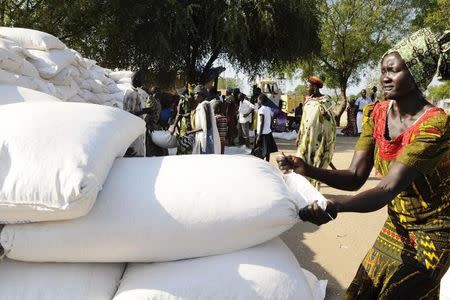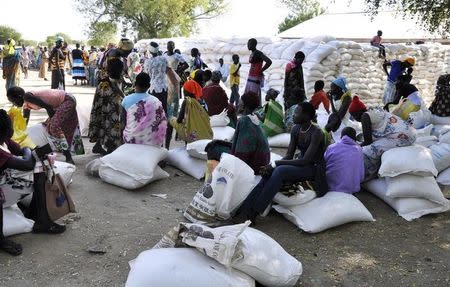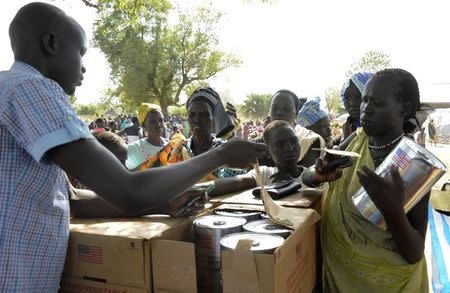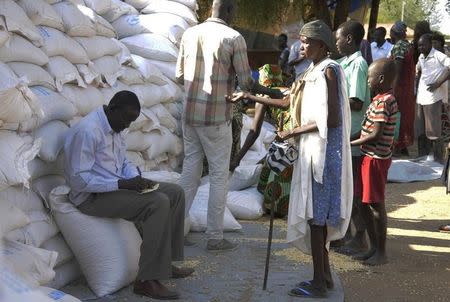Famine threat to South Sudan if war continues to block aid
By Katy Migiro JUBA (Thomson Reuters Foundation) - In the swampy frontlines of South Sudan's conflict, women spend hours pounding wild fruits, water lilies and grasses to feed their children, just two months after the harvest. Aid workers fear famine will again threaten South Sudan in the next few months if forces loyal to President Salva Kiir and his rival Riek Machar continue to shell food distributions, loot aid and menace humanitarian staff. Fighting which erupted in December 2013 has forced two million people to flee their homes, killed up to 50,000 people and hurt efforts to tackle South Sudan's chronic hunger problem. One in five South Sudanese -- 2.5 million people in total -- will need food aid up to March, 1 million more than in September, experts said in the latest Integrated Food Security Phase Classification (IPC) assessment released this week. According to the analysis, 1.6 million people are in crisis and 890,000 in emergency -- phases three and four on a five-point scale where five is famine. "If the guns don't fall silent for humanitarian support to go in, they would still be having this looming possibility of localized famine," said Bernard Owadi, World Food Programme's (WFP) lead food security analyst in South Sudan. MANIPULATED AID Ensuring South Sudan's population has enough to eat is a constant battle in a country where large swathes of land are cut off and where roads only exist for a few, dry months each year. "It's the most complex operational country (in the world)," said Peter Schaller, WFP's chief of logistics in South Sudan. "You need about 10 contingency plans for one task." Poor infrastructure and security issues make it harder to work in South Sudan than the Democratic Republic of Congo and the Central African Republic, he said. Delivering aid into war zones is a logistical nightmare, requiring lengthy negotiations and clearances from warring parties. From Somalia to Syria, aid can often end up in the wrong hands. Hungry soldiers in South Sudan, who struggle to get resupplied, use firepower, force and manipulation to try to requisition aid intended for their starving populations. While the militant group al Shabaab blocked food aid from reaching famine-stricken Somalis in 2011, South Sudan's fighters have long siphoned it off to feed themselves and control populations. In camps in the capital Juba, women uprooted by conflict carry 50kg sacks of sorghum, the country's staple food, complaining it was the first food they had received in four months due to a dispute between their leaders and aid agencies. "I don't know why we didn't receive food," said Angelina Nyagang Mat, in a red and yellow headscarf and dangling earring, her face beaded with sweat. "The only ones who know are the camp chairman and the U.N." NIGHTMARE Unlike many parts of the world where food aid is presented in cash or vouchers -- for local goods replacing food shipped half way round the world -- in South Sudan, agencies are still using planes, trucks and barges to bring in supplies. From May to December, nearly 70 percent of South Sudan can only be reached by air due to flooding. This gives relief groups five dry months to deliver and store a year's worth of aid. WFP deploys 1,000 commercial trucks, supplied by 32 different companies, to make road deliveries in South Sudan. Last year, 180 trucks got stuck in the mud for five months. The agency had to bring in murram and bulldozers to repair the roads and get the vehicles out. "Every convoy passing through conflict areas means a lot of sleepless nights," said George Fominyen, WFP's spokesman in South Sudan. Another problem is finding people brave enough to make the deliveries. Transporters who have been held up at gunpoint and had their food stocks looted do not return. Agencies cannot send Dinka staff into Nuer areas and vice versa, following massacres along ethnic lines. In August, six aid workers were killed in Upper Nile state. "A lot of staff left because of the ethnic situation," said Vilma Tyler, Unicef's chief of nutrition. Operations in which relief agencies cross between government- and rebel-held territory are the most dangerous. Usually these areas can only be reached by air as it is too risky for trucks to travel the same roads as hungry troops. WFP has four Ilyushin cargo planes, four Mi8 helicopters and two Mi26s, one of the largest helicopters in existence, to make air deliveries. The hungriest people are the ones closest to the front lines. And they keep moving. In the time it takes to carry out an assessment and negotiate access, fighting can force people to flee again, aid workers said. "They scatter. So when you had one location to do the distribution, suddenly you find they have dispersed to five, seven, eight other locations," WFP's Schaller said. Famine warnings were issued for the period between June and August last year, when four million people needed food aid. The crisis eased in September due to a massive influx of aid and rains leading to a harvest. But food stocks are running out again, people on the move cannot farm and there is virtually nothing on sale in active conflict zones. The latest IPC analysis said in the three worst-hit areas, more than 30 percent of children are malnourished and nutrition is 'very critical', phase five on a five-point scale. "We are not talking famine right now, but the situation is dire," said Tyler of Unicef. "If we do not continue to intervene, and intervene right now, we are going to end up with children dying. We are going to end up having famine." (Editing by Katie Nguyen)





